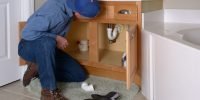Last Updated on March 18, 2024 by Kelvin Nielsen
As a renter in Colorado, you have a right to live in a habitable home. The law requires that landlords provide a home that meets the state’s basic health, safety, and building codes.
If the landlord isn’t able to do so, the home would be deemed to be uninhabitable. And consequently, you may be able to exercise a few legal options.
The following are answers to commonly asked questions regarding uninhabitable living conditions in Colorado.
What Are Uninhabitable Living Conditions in Colorado?
Basically, uninhabitable living conditions in Colorado are those that violate the state’s warranty of habitability.
The following are examples of conditions that may qualify your Colorado home as uninhabitable under state law.
- If the roof is leaking or exterior walls are allowing water to seep in.
- If the exterior doors or windows are broken.
- If there are gas problems that may potentially lead to a fire outbreak or an explosion.
- The presence of mold in the unit that results from dampness.
- If the electrical lighting or wiring is poor and can lead to a fire outbreak.
- If there are pests in the home.
If any of these conditions exist in your home, then that may mean the home is no longer habitable.
Under the Colorado warranty of habitability, landlords are required to, among other things, provide heating, hot water, and smoke and carbon monoxide detectors. In addition, they must also make needed or required repairs to the unit.
What Happens if Your Landlord Doesn’t Fix Things in Colorado?
If your landlord fails to provide a habitable home or doesn’t fix things when you request him to, you may be able to exercise a few legal options.
#1: Provide the landlord with a written notice.
Let the landlord know of the problem. In the notice, make sure to describe the problem in detail. Also, mention when it began, as well as what you would like the landlord to do to repair it.
It goes without saying that the notice must be written. And last but not the least, send it either by mail, email, or through personal delivery.
#2: Allow the landlord time to fix the issue.
Under the Colorado warranty of habitability, landlords have a responsibility to make repairs within a reasonable time after proper notification by tenants. Specifically, this should be anywhere between 24-96 hours.
For emergency repairs, a landlord must fix a requested repair within 24 hours. Examples of emergency repairs include a water leak or a broken furnace.
For non-emergency repairs, landlords must make repairs within 96 hours of being notified. Examples of non-emergency repairs include burnt our light bulbs or parking disputes.
#3: Repair the problem and deduct the cost from your rent.
As a renter in Colorado, you may be able to make a repair yourself and then deduct the cost from future rent. However, you must do it right lest the landlord uses that as a ground to evict you from the property.
If the landlord doesn’t respond to your first notice, send a second one. You should send it at least 10 days before exercising your right to repair and deduct. In the notice, let the landlord know that you intend to do the repair yourself and deduct the cost from the rent.
#4: Break the lease and move out.
Another legal option you have when a landlord fails to make repairs on time is breaking the lease without penalty. Again, you must allow your tenant at least 10 days to fix the problem before breaking your lease.
#5: File a complaint with the Colorado Department of Housing.
If nothing seems to work, you can consider filing a complaint with the state’s Department of Housing. The department will investigate your claims and take any necessary action against the landlord.
#6: Sue the landlord in court.
You may also be able to sue your landlord in court for not making repairs within reasonable time. If you are successful in your suit, you may be able to recover damages, as well as attorney and court costs.
What is the Roaches in Apartment Law In Colorado?
The Colorado warranty of habitability requires landlords to provide a pest-free home. Common pests in Colorado include ants, bed bugs, elm beetles, box elder bugs, and cockroaches.
With that in mind, Colorado doesn’t have a roaches in apartment law. However, both you and your landlord have certain responsibilities when it comes to preventing a roach infestation.
As a tenant, you have a duty to keep the unit clean and free of food debris, repair any leaks, and avoid leaving pet food and water out overnight, among other things. As for your landlord, they have a duty to provide you with a pest-free home when you first move in, ensure regular garbage disposal, seal cracks and crevices around the property, and fix leaks and damp areas, among other duties.
So, what are you to do if you find roaches in your home? You must notify the landlord immediately. The landlord must then take reasonable steps to get rid of the infestation, which may include hiring a professional exterminator.
Again, if the landlord isn’t able to make the repairs, you may be able to exercise a few legal options. Including, breaking the lease without penalty, suing the landlord, or repairing the issue and deducting the costs from the rent.
What Are The Minimum Heating Requirements for Landlords in Colorado?
Landlords in Colorado must abide by certain minimum heating requirements. You must provide heating facilities that are capable of maintaining a temperature of at least 70 degrees Fahrenheit at a distance of at least 3 feet above floor level, when the outside temperature is minus 5 degrees Fahrenheit.
If the landlord fails to meet these minimum heating requirements, you may have several options. Including, breaking the lease without penalty and suing the landlord for breach of the warranty of habitability.
What are Colorado tenants’ rights to withhold rent?
As a tenant in Colorado, you have a right to withhold rent if your landlord breaches the warranty of habitability. The following are examples of uninhabitable living conditions that may breach the state’s warranty of habitability.
- Broken windows or locks
- Lack of heat or running water
- Severe pest infestations
- Structural issues
- Mold or mildew infestations
- Unsafe electrical wiring or plumbing
- Broken locks or windows
And just like in the repair and deduct option, you must notify the landlord of the condition. You must then give them reasonable time to fix the condition. You must, however, deposit the rent into a separate escrow account. This will show the landlord that you’re serious about the repairs and not simply taking advantage of the situation to pay rent.
With that in mind, please note that withholding rent is a risky move. If you don’t do it right, the landlord may be able to use that as a legal ground to evict you from the property. So, before exercising this right, it would be important for you to do due diligence.
Conclusion
The Colorado landlord tenant law on repairs is clear on what constitutes uninhabitable living conditions and what rights a tenant has. If you have more questions on the topic, please do remember to leave a comment down below.
Disclosure: The content herein isn’t a substitute for advice from a professional attorney. It’s only meant to serve educational purposes. If you have a specific question, kindly seek expert attorney services.
Sources: Warranty of Habitability in Colorado, Residential Tenants’ Health and Safety, Colorado Landlord Responsibilities,

Hi, I’m Kelvin Nielsen, an experienced landlord and accomplished real estate lawyer. My focus is on answering your questions about renting in the hopes of making your life as a renter or a landlord a bit easier.







